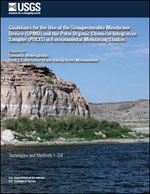The success of an environmental monitoring study using passive samplers, or any sampling method, begins in the office or laboratory. Regardless of the specific methods used, the general steps include the formulation of a sampling plan, training of personnel, performing the field (sampling) work, processing the collected samples to recover chemicals of interest, analysis of the enriched extracts, and interpretation of the data. Each of these areas will be discussed in the following sections with emphasis on specific considerations with the use of passive samplers.
Water is an extremely heterogeneous matrix both spatially and temporally (Keith, 1991). The mixing and distribution of dissolved organic chemicals in a water body are controlled by the hydrodynamics of the water, the sorption partition coefficients of the chemicals, and the amount of organic matter (suspended sediments, colloids, and dissolved organic carbon) present. In lakes and oceans, stratification because of changes in temperature, water movement, and water composition can occur resulting in dramatic changes in chemical concentrations with depth (Keith, 1991). Additional complications related to episodic events, such as surface runoff, spills, and other point source contamination, can result in isolated or short-lived pulses of contaminants in the water.
The application of passive sampling technologies for the monitoring of legacy and emerging organic chemicals in the environment is becoming widely accepted worldwide. The primary use of passive sampling methods for environmental studies is in the area of surface-water monitoring; however, these techniques have been applied to air and groundwater monitoring studies. Although these samplers have no mechanical or moving parts, electrical or fuel needs which require regular monitoring, there are still considerations that need to be understood in order to have a successful study.
Two of the most commonly used passive samplers for organic contaminants are the semipermeable membrane device (SPMD) and the polar organic chemical integrative sampler (POCIS). The tips given in this document focus on these two samplers but are applicable to most types of passive sampling devices. The information in this guide is heavily weighted towards the sampling of water; however, information specific to the use of SPMDs for air sampling will also be covered.


